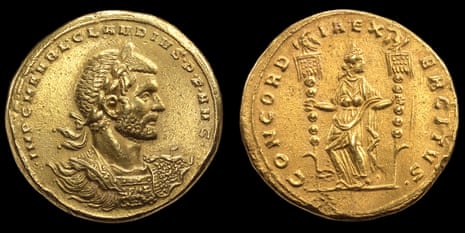The trial is under way in Marseille of a man accused of smuggling a national treasure after being caught with a Roman plate that is believed to be part of a mysterious hoard of sunken gold.
The hearing is the latest twist in what is known as the “Lava treasure saga”, which began almost 40 years ago when three men went fishing for sea urchins in the Mediterranean off the west coast of Corsica in 1985.
Félix Biancamaria, who is appearing in court, his twin brother and a friend discovered at least 100 rare gold coins dating back to the third century and bearing the heads of Roman emperors. The two-day hearing ends on Tuesday and a verdict is not expected immediately.
Biancamaria, now 67, from the Corsican capital, Ajaccio, was convicted in 1994 of having sold the coins and received an 18-month suspended sentence and a €15,000 fine. At the time, nothing was known about the plate he had discovered.
However, in 2010 he was arrested by police at Paris’s Charles de Gaulle airport and found to be carrying in his bag a rare golden plate, valued at between €6-8m, from the same find. Biancamaria is now on trial accused of trying to sell it illegally to Jean-Michel Richaud, who is also in the dock.
Biancamaria has never denied finding hundreds of gold coins and the plate along with other treasures. In a book, he described prising the plate from under a rock on the seabed using a tank jack. Treasure found at sea is considered to belong to the state. However, in court on Monday Biancamaria claimed he had found the plate on land, which would mean it partly belonged to him as the finder.
Despite searches, no wreck from which the gold could have come has been found. Biancamaria’s lawyer, Anna-Maria Sollacaro, says this effectively sinks the state’s case and has also contended – in an interpretation disputed by opposing lawyers – that at the time of the discovery the law giving maritime discoveries to the state applied only to items that came from wrecks.
Without such proof the treasure belongs to her client, Sollacaro has argued. “The problem is that no wreck has ever been found in the case, not even the slightest trace that could prove that this treasure actually came from a wreck,” she told French media before the hearing.
Historians and archaeologists believe the treasure was made up of up to 1,400 coins struck during the time of four Roman emperors: Gallienus (253-268), Claudius “Gothicus” II (268-270) Quintillus (270) and Aurelien (270-275).
The plate is believed to have been decorated with a medallion at the centre bearing the head of Gallienus and a diamond, but while the French police retrieved the plate, they say they have never found the medallion.
Michel L’Hour, a marine archaeologist and a former director of the Department of Underwater and Subaquatic Archaelogical Research (DRASSM), said the coins were “the most important monetary treasure that we know from the 3rd century”. He said he was convinced a solid gold statuette was also discovered by the three fishers, which they deny.
On Corsica, island legend has various theories: some say it came from a shipwreck off the coast, others that it was hidden on the island and fell into the sea after a landslide.
Jean-Luc Boyer, the deputy head of France’s Central Office for Combatting Trafficking in Cultural Property, said: “Treasures and antiques discovered at the bottom of the sea of our territory belong to the state. However, if it was found on land, the law is a little different; part could belong to the finder, but they are obliged to make a discovery declaration to the state via the culture ministry.”
In his 2004 book, Le Trésor de Lava (The Lava Treasure), Biancamaria said he, his brother and friend had found between 450 and 500 of the gold coins. “I think we melted down 40 that were in the worst condition,” he wrote.
